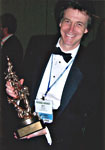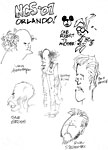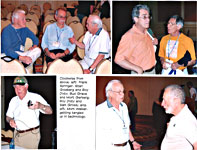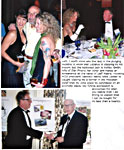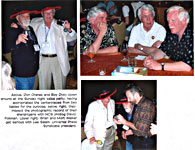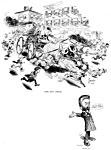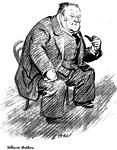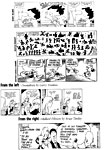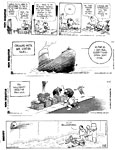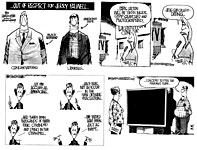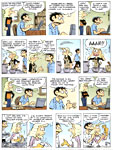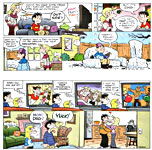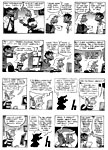 |
|||||||
|
Opus 206 (June 5, 2007). In our report on the annual meeting
of the National Cartoonists Society, we announce the winner of the Reuben as
Cartoonist of the Year, plus the winners in the numerous “division”
competitions, and we rehearse some of the doings that were done over Memorial
Day weekend in Orlando where the inkslingers met. We also report on Berkeley
Breathed’s correction of the impression that he was going to kill off Opus and
on the discovery of a cartoon torture manual in Iraq. We discuss the legacy
issue in comic strips, bemoan the final closing of the Gotham Book Mart, note
the Falwell furors in political cartoons, and do a lingering review of the
first reprint collection of the comic strip Edge City before commemorating the
40th anniversary of the debut of Sgt. Pepper and his Lonely Hearts
Club Band. Here’s what’s here, in order, by Department:
NOUS R US
Berk
Breathed on the No Longer Dead Opus
Fred
Schodt on Osamu Tezuka
Salicrup’s
Birthday and a New Tales of the Crypt
Ageism
at Disney
Cartoon
Torture Book
CARTOONIST OF THE YEAR
Report
on the Annual NCS Meeting and Award Winners
Immigration
Nonsense
FUNNYBOOK
FAN FARE
Rawhide
Kid
Marvel
vs. DC
Civilization’s
Last Outpost
Ray
Bradbury on Fahrenheit 451
COMIC STRIP WATCH
Recent
Notables
The
Legacy Question
BOOK MARQUEE
Fletcher
Hanks
Un-Spun,
A Guide to Making Sense of Political Shenanigans
Gotham
Book Mart Closes
EDITOONERY
Falwell
Furors
Walt
Handelsman Samples
EDGE CITY
Book
Review
JuneOne
Sgt.
Pepper and Paul McCartney
And
our customary reminder: don’t forget to activate the “Bathroom Button” by clicking
on the “print friendly version” so you can print off a copy of just this
lengthy installment for reading later, at your leisure while enthroned. Without
further adieu—
NOUS R US
All the News That Gives Us Fits
The
effervescent Berkeley Breathed, creator
of Bloom County, Outland and Opus, admitted recently that his wit
sometimes runs away with his mouth. As we reported here last time, the
cartoonist alluded to the impending death of his famed penguin, Opus. That,
however, is not in the offing. “I was kidding about killing Opus,” Breathed
confessed to Douglas Wolk at Salon.com. In the same interview, Breathed plugs
his new children’s book, Mars Needs
Moms!, and laments the sad state of affairs GeeDubya has created for
satirists. “His ridiculousness is approaching the sort of existential absurdity
that is untouchable,” Breathed said. “I can’t make him any funnier than when
he’s trying to explain himself in a town hall meeting. Any day now, he will go
with ‘I’m the decisioner,’ and we satirists will know that our balls have been
cut off entirely by a very shrewd adversary. Reagan did this too by becoming
senile.” You can read the whole enchilada (and Breathed is always a treat to
read) at http://www.salon.com/books/feature/2007/06/03/breathed But is he really kidding about killing Opus?
Or is he merely ducking responsibility for what he let slip out last month? I
still think Opus is not long for this world. But then I thought the Republicans
would retain control of Congress last November, too.
Fred
Schodt, who wrote the seminal study of Japanese comics, Manga! Manga! The World of Japanese Comics,
in 1983, pondered the present state of the genre on May 29 with Robert Taylor
of MediaNews. “When I was in college,” Schodt said, “it was sort of like rock
’n’ roll—part of youth culture. I remember these students carrying these big
fat manga around. And there was a certain amount of cachet to reading a
magazine ‘backwards,’ from right to left. Now you can be a manga fan in an
American high school and not be thought of as weird. But of course if it
becomes too mainstream, the kids will go on to something else.” Schodt’s book
has a Foreword by Osamu Tezuka, “the
god of manga.” “He was a genius,” said Schodt. “When I met him in the 1970s, he
was already an exalted figure in Japan. In terms of social respect, Tezuka
ranks up there with JFK and Gandhi. A lot of people have called Tezuka the Walt
Disney of Japan ... [but] Walt Disney was primarily an entrepreneur; Tezuka was
primarily a creator. He drew more than 150,000 pages in his lifetime.” Many of
those are now on display in the Asian Art Museum in San Francisco, the only
U.S. venue for the exhibit.
On June 2, the Museum of Comic and
Cartoon Art in New York celebrated the 50th birthday of Jim Salicrup and his 35-plus years in
comics. Once an editor at Marvel and editor-in-chief at Topps, Salicrup has for
the past few years been engineering titles in NBM’s young adult graphic novel
imprint, Papercutz. To its series of manga-like modernizations of Nancy Drew
and Hardy Boys novels, Papercutz is adding an anthology title, new stories
under an old and honored banner, Tales of
the Crypt—evoking the fabled EC Comics line of the 1950s. Conceived as a
bi-monthly title, the 48-page comic book will debut in June, saith Kate Culkin
at PW Comics Week; periodically,
stories published in the comic book will be compiled for trade book
collections.
The Mouse House has been accused of
a particularly sinister brand of agism. In a Brigham Young University study of
93 Disney characters who appeared to
be aged 55 or older, according to Britain’s Daily
Mail, “a significant majority were depicted as either nasty and
bad-tempered or dotty and useless: 25 percent were shown as grumpy, 12 percent
as evil or sinister, 8 percent helpless, 3 percent senile or crazy, and 2
percent the object of ridicule.” Reporting in the Journal of Ageing, the researchers expressed alarm that children,
witnessing these insidious portrayals of their elders, “could form a negative
impression of them.” Could be.
U.S. troops who invaded an Al-Qaeda
“safe house” some weeks ago found a torture manual in comic book form. As
reported at newspaper.asia1.com, the drawings in the booklet “were a horrific
how-to torture guide,” created “presumably to teach terrorists what to do with
their victims to force them to talk. Some images showed how to drill hands,
sever limbs, drag victims behind cars, remove eyes, and put a blowtorch or iron
to someone's skin, according to the Fox News Channel. Others showed how to suspend
a person from a ceiling and electrocute them, break limbs and restrict breath
and put someone's head in a vice.” CNN quoted a military spokesman: 'They made
it in a cartoon manner, so that no matter what your literacy rate, what
nationality you are, all you've got to do is look at these pictures to
understand how to conduct tortures of innocent people.” Not having seen this
grisly manual, I can only suppose that the miliary spokesman said it took the
form of a comic book because the pictures accomplished their instruction by
depicting actions in sequence. Terrible as this deployment of the artform is,
it is also a vivid testimony to the effectiveness of comics in communicating.
It’s apparently final: Frank Miller has written the script and
will direct the Lionsgate film adaptation of Will Eisner’s masked crimefighter, the Spirit. Said Miller: "Will was a dear friend, a
mentor, and translating his vision to the screen will be a labor of love.”
Miller's "vision is perfectly matched to that of Eisner," said
Lionsgate Theatrical Films prexy Tom Ortenberg.
Fascinating
Footnote. Much of the news
retailed in this segment is culled from articles eventually indexed at http://www.rpi.edu/~bulloj/comxbib.html, the Comics Research Bibliography, maintained by Michael Rhode and John
Bullough, which covers comic books, comic strips, animation, caricature,
cartoons, bandes dessinees and
related topics. It also provides links to numerous other sites that delve
deeply into cartooning topics. Three other sites laden with cartooning news and
lore are Mark Evanier’s www.povonline.com, Alan Gardner’s www.DailyCartoonist.com, and Tom Spurgeon’s www.comicsreporter.com.
And then there’s Mike Rhode’s ComicsDC blog, http://www.comicsdc.blogspot.com
CARTOONIST OF THE YEAR, ETC.
National Cartoonists Society Launches
Its Raft of Annual Awards
Every
year in the spring, the NCS recognizes excellence in various categories of
’toonery endeavor, giving awards to a dozen or so cartoonists, some of whom,
but not all, are members of the Society, a circumstance heavy with the
implication that self-aggrandizement is not the only agenda. For the first ten
years after the Society’s founding in 1946, the only award given was to the
Cartoonist of the Year. In the mid-fifties, other more specialized
achievements—in comic strips, editorial cartoons, single panel gag cartoons (in
both newspaper and magazine), and sports cartoons—were added to the honor roll.
Today, comic books, advertising cartoons, book illustration, and animation
lengthen the list to an even dozen. Sometime in 1953 or thereabouts, when Bill
Crawford saw a lamp that the venerable Rube Goldberg had sculpted into a
pyramid of cartoony nudes, Crawford realized that it would make a perfect
trophy for the Cartoonist of the Year, and so the Reuben was born, supplanting
the earlier memento, a silver cigarette box engraved with the characters from Barney Google and called the Billy
DeBeck Memorial Award in remembrance of one of the fraternity’s more revered
departed, the creator of the aforementioned Google. Very early in the evolution of its
awards program, NCS took to meeting in posh surroundings. For years, the annual
ceremony took place at the fanciest hotel in New York, the Plaza, at the corner
of Park Avenue South and Fifth Avenue. And attire for the ceremonial banquet
was strictly black tie and tails. The purpose was wholly public relations. The
idea was to show that cartoonists were not, reputations to the contrary
notwithstanding, grubby ink-stained and unshaven bohemians, slaving away in
attics by day and brawling in saloons at night. Some cartoonists may have
worked and lived in exactly this manner, but once a year, for the Awards
Banquet, they dressed up and put on the dog to convince the world at large that
they were not only respectable citizens but fancy-dress members of the upper
classes in the entertainment industry. And whoever was designated Cartoonist of
the Year was expected—nay, commanded—to exploit the honor to heighten the
visibility of his cartoon feature, to garner thereby increased circulation,
greater fame, and enhanced income. It was all very practical, very mercenary.
Over the years, much of the
insidious merchandising purpose underlying the occasion has receded into the
dimmer recesses of the collective NCS memory. But the outward and visible signs
are steadfastly maintained. And so the Society meets in a posh place—this year,
the Ritz Carlton Hotel in Orlando, Florida, that vast recreation venue that
Walt Disney created where once there was only a swamp. The venue for this year’s Event, the
Ritz Carlton Hotel, while posh and exotic enough, was a fiendishly isolated
locale. As a resort, it offered few recreations on the premises— swimming and
golf. And drinking and eating. To indulge in any other disportment, you had to
leave the property, but the hotel offered no complimentary transportation
service to any of the area’s plethora of wonders—SeaWorld, Disney World, Epcot,
Universal Studios World, MGM, etc. To get to any of these places, you had to
hire one of the hotel’s town cars, engage a taxi, or rent a Hertz car. While golf has been a big attraction for the
upper reaches of NCS membership, the Orlando location was chosen, presumably,
for the other amusement possibilities it offered the families of cartoonists,
some of whom are not golfers. And yet the hotel selected amid all these
attractions made it difficult—well, expensive—for anyone to take advantage of
their proximity. The perversity of this year’s destination decision ironically
underscores the loss of purpose that has, over the years, left the awards
adrift. All that is left of the original scheme is the costliness of the site
of the festivities. The leadership of the Society persists in chasing after the
most luxurious and expensive hotel destinations (“five star,” “five diamond”)
as if luxury alone were the object of the Event. And the Ritz Carlton is
perfect for that: it offers little other justification as a destination.
In defense of the such choices of
venue, it is said that the Reubens weekend is a “party” for cartoonists, a
celebration of themselves wherein they gather over drinks in raucous good
fellowship. The craziness is more myth than reality, the reputed zaniness of
cartoonists notwithstanding. As Dan
Piraro, this year’s master of ceremonies, said: “Most of these guys are not
all that crazy in person. Imagine a group of middle-aged characters in golf
shirts and hagar slacks, drinking heavily. That’s a cartoonists convention. I
like all these guys, don’t get me wrong. But there are only about five that are
what you’d call crazy.” Bill Amend,
who had joined Piraro for an online chat, disagreed: “Actually, it’s insanely
crazy. We just wait until Dan goes to bed before we let loose.”
Nurturing good fellowship is a
worthy enough goal in itself, no question. But camaraderie can be fostered in
surroundings much less expensive than “five diamond” hotels. And since
ostentation is no longer the publicity stunt rationale for the annual
gathering, why not seek more affordable accommodations? Something most
cartoonists, who are no longer as well-paid as they once were, could aspire to.
But then, if they wanted my opinion, they would have asked for it, right? And
since they didn’t, let us proceed apace to the ostensible purpose of this
report—to announce the winners of all those awards.
Bill
Amend was named Cartoonist of the Year for selflessly creating hundreds
opportunities for young cartoonists on the nation’s comics pages by retiring
the daily edition of his comic strip, FoxTrot, last fall. No, I’m kidding: that’s not why Amend received the Reuben trophy
for Cartoonist of the Year from the National Cartoonists Society at their 61st annual meeting, this year held at the Ritz Carlton Hotel in Orlando, Florida,
May 25-27. He earned the esteem of the inky-fingered fraternity with the
consistently high quality of his comic strip over its 19-year run. That’s why
he got the Reuben. During the ceremonial presentation
banquet, Beetle Bailey’s Mort Walker received the Gold Key
Award, the Society’s equivalent of a Hall of Fame. Others in the Hall of Fame
are Hal Foster (Prince Valiant), Edwina
Dumm (Capt Stubbs and Tippie), Raeburn Van Buren (Abbie ’n’ Slats), Herbert
Block (Herblock, editorial
cartoonist), Rube Goldberg (Boob McNutt and editorial cartoons), Milton Caniff (Terry and the Pirates and Steve Canyon), and Arnold Roth (freelance). Walker, a past president of NCS and previous winner (in 1953) of
the Reuben, has won just about every award the Society bestows, except the
Milton Caniff Lifetime Achievement Award; and he’ll doubtless get that ere
long.
In accepting the Reuben, Amend, a
slender wraith of a man with a prison pallor and an enviable mop of fluff-dried
and therefore unruly hair, marveled at the trophy’s considerable weight,
asking, midway through his acceptance remarks, if someone else could hold it
for him. He said he was afraid he might fall and impale himself on it, alluding
to the pointy stopper of the ink bottle that surmounts the statuette’s pile of
goofy naked humanoids.
In an online interview conducted May
18 by Suzanne Tobin, comics page editor at the Washington Post, Amend remarked about his decision to discontinue
the daily FoxTrot instead of turning
it over to another cartoonist to perpetuate: “I’ve always viewed my strip as a
personal form of expression/observation more than a business, and the thought
of continuing it with others at the helm just seems wrong to me.”
Commenting on so-called “legacy
strips” and the occasional crusade to expunge them from the funnies, Amend
said: “I won’t say older strips should be dumped, but I wish that when
newspapers did surveys or otherwise gauged reader opinion, they gave younger
readers more clout than they currently seem to. It does sometimes seem as
though the comics section is aimed to please the over-60 crowd way more than
the under-30 one. Which doesn’t help newer cartoonists get a toehold in papers,
and it doesn’t encourage younger readers to develop the habit of reading the
paper. It’s definitely tough to convince a newspaper to drop a classic for a
new strip. I’m glad I got the breaks I did when Bloom County and Calvin ended
and freed up some space.”
Amend doesn’t think comics are a
dying art form: “While newspaper cartooning is certainly feeling a squeeze
these days,” he remarked, “the rising popularity of webcomics makes it pretty
clear that people still like to draw cartoons and people still like to read
them. The challenge is to figure out how to earn a living off of web content.”
Answering a question about why he
didn’t let his characters grow older, Amend said: “I created the FoxTrot characters such that they would
play off of each other in interesting ways. Were I to age the kids even a
couple of years, the changes in their interests/maturities would affect the
whole structure of things, and I wasn’t interested in doing that in such an
irreversible way.”
More about Amend and his adventures
creating FoxTrot can be found in the
Hindsight department; click here.
Runners-up for the Reuben this year
were both creators of single-panel cartoons: Dave Coverly, who does Speed
Bump, and Dan Piraro with Bizarro. All three have been nominees in
previous years. Quipped Amend: “NCS dues came in a little short this year, so
they just used last year’s ballots to save money. The three of us objected
strenuously, of course.”
About legacy strips, Piraro said:
“You could argue that older strips should be dropped, but I guarantee that
almost any [strip] you choose [to drop] will have millions of daily readers who
consider it an irreplaceable part of their daily routine.”
Added Coverly: “Yeah, I don’t really
feel like it’s my place to say whether older strips should be dumped. With a
little luck, I’ll be drawing one of those older strips someday. Newish strips I
do like are Pearls Before Swine and Frazz, but, like Dan, I don’t read the
comics much—in part because I don’t like seeing good ideas I should have come
up with myself.”
In March, members of NCS voted by
mail on the slate of candidates for the Reuben. Earlier in the winter, NCS
chapters juried submissions in the twelve categories, or “divisions,” of
cartooning, picking three finalists in each. Herewith, I list the finalists in
all divisions (being a finalist, given the competition, is a distinction
itself, not to be overlooked in the breathless excitement of learning who the
winners are), prefixing the winner’s name with an asterisk (*):
Comic
Strip—Bill Griffith’s Zippy the
Pinhead; Mark Tatulli’s Lio; and
*Stephan Pastis’ Pearls Before Swine.
In accepting, Pastis paid tribute to the late King Features editor, Jay
Kennedy, who responded to Pastis’ submission by personal letter, without which
encouragement, Pastis said, he may not have continued to develop his strip.
(Pastis was eventually syndicated by United Media, not King.) Newspaper Single Panel Cartoon—Tony
Carrillo’s F-Minus; *Hilary Price’s Rhymes With Orange; and Kieran Meehan’s Meehan. (According to E&P's syndicate directories, Meehan
formerly created Meehan Streak for
Tribune Media Services and now does A
Lawyer, A Doctor & A Cop for King.) Newspaper Illustration—Sean Kelly, Robert Sanchuk, and *Laurie
Triefeldt, who produces World of Wonder, a weekly illustrated feature page with educational implications, demystifying
such things as “storms,” “castles,” “bugs,” “magnets,” “Vikings,” “night
creatures,” and “ancient Greece,” worthy topics all.
Gag Cartooning—*Drew Dernavich, Mick
Stevens, P.C. Vey. All are New Yorker ’tooners,
a circumstance that vividly reflects the shriveled state of today’s market for
magazine cartooning, but it also makes me wonder why no Playboy cartoonists were among the finalists, Hefner’s magazine
being the only other gold-standard outlet for gag cartooning. Editorial Cartooning— Mike Lester of
the Rome (Ga.) News-Tribune; Glenn
McCoy of the Belleville (Ill.) News-Democrat; and *Mike Ramirez of Investor's Business
Daily. Interestingly, as E&P’s David Astor observed when the nominees’ names were first published, all three
finalists are conservatives in a cartooning profession consisting mostly of
liberal and centrist creators. (Makes me wonder which chapter did the editorial
cartoonist selection this year.) Doonesbury’s Garry Trudeau announced the winner in this category, and his
tongue-in-cheek recitation of the names of the finalists acknowledged the
oddity: Lester “on the right,” McCoy “on the far right,” and Ramirez “on the
knuckle-dragging right.”
Comic
Book—This category once again reflects NCS’s historically abysmal
appreciation of this genre. All three nominees are creators of graphic novels,
not comic books: Acocella Marchetto (Cancer
Vixen), Marjane Satrapi (Chicken with
Plums), and *Gene Luen Yang (American
Born Chinese), who made headlines earlier this season when his book was the
first graphic novel to be nominated for (but didn’t win) a National Book Award
for juvenile fiction. (NCS will adjust its sights somewhat in the future, I’m
told, creating a new category for Graphic Novel.) Book Illustration—*Mike Lester (93
in My Family); Wiley Miller (The
Extraordinary Adventures of Ordinary Basil); and Adrian Sinnott (Caveman Manners). Greeting Card— *Carla Ventresca, Pat Byrnes, and Kevin Ahern.
Feature
Animation— "Over the Hedge” (based on the comic strip of the same name
by Michael Fry and T Lewis; directors Tim Johnson and Karey Kirkpatrick);
*"Open Season" (character design, Carter Goodrich); and“Ice Age 2:
the Meltdown” (character design, Peter De Seve). Television Animation—David Hulin (“Geico Gecko”), Steve Loter (“Kim
Possible”), and *Craig McCracken (“Foster’s Home for Imaginary Friends”). Advertising Illustration— Craig McCay,
Jack Pittman, and *Tom Richmond. Magazine
Illustration—*Steve Brodner, Tom Richmond, and Jean-Jacques Sempe.
The NCS Silver T-Square, given
occasionally to “persons who have shown outstanding service or contributions to
the Society or the profession,” was presented to the sons of NCS’s
Dan Piraro again applied his acerbic
wit to mastering the evening’s ceremonies, but he
cast
a pall of gloom over the proceedings almost at once by announcing that this
year would be his last at the podium. Several of us speculated that Steve McGarry will be Piraro’s
successor. This year’s pre-registered attendance stood at 145 cartoonists, plus
their wives, children and miscellaneous hangers-on, a grand total of perhaps
300 souls, a somewhat smaller crowd that at other recent Reubens festivities,
which usually attract over 400 people. Maybe the destination wasn’t as
attractive this year as in previous years. Who can say? Of the twelve division
winners, one third—four—weren’t in attendance to receive their award. There are
usually a few absentee winners, but it seems to me this year’s muster was a
little larger than usual. Purely a subjective reaction, though, as I’m sure you
can tell.
The awards banquet has in recent
years acquired an encompassing “program” of presentations by sundry of the
Society’s members, swelling the occasion from an evening’s ceremony to a
three-day Event. On Friday and Saturday, afternoons are devoted to
presentations; on Sunday, the afternoon is free of programming, leaving us all
at loose ends, desperate to find some worthwhile way to spend the hours until
the concluding event that evening. For the past several years, Sunday evening
was devoted to “roasting” one of the Society’s more distinguished members.
Beginning with Bil Keane (who, as master of the revels, had enlivened the
awards
presentations
with hilarious sarcastic comments about his brethren and who therefore deserved
a thorough roasting), the next few Roasts skewered Mell Lazarus, Sergio
Aragones, and Cathy Guisewite. This year, thankfully, the Roast disappeared; it
had become increasingly distasteful. The Friday night karaoke also disappeared
this year. The combined loss of frivolity effectively nullifying the claim that
the weekend was a “party” for cartoonists. All that remained was a series of
cocktail hours. But the Sunday night cocktail party and erstwhile Roast was
re-tooled as a “Salsa Dance” party in the misbegotten belief that everyone
wanted to dance. Few did. At Sunday morning’s brunch, I met Percy Crosby’s
daughter, Joan Crosby Tibbets, who
has been, for decades, trying to get the makers of Skippy peanut butter to
compensate her for their poaching on her father’s famous comic strip
character’s turf; the tale is retailed in our Hindsight department, here.
It was a delight to meet Joan (and her daughter Kim), a charming and outgoing
lady with a sultry voice like Tallulah Bankhead.
Friday afternoon’s presentations
featured Jerry Van Amerongen and
Mort Walker. Amerongen, whose offbeat newspaper panel cartoon Ballard Street (which replaced his
equally offbeat The Neighborhood in
1990) was named best panel cartoon in 2003 and 2004, presented a series of his
favorite cartoons and talked about how his odd ideas occur to him and take
form. Walker, chosen, doubtless, because he would later be honored with the
Gold Key Award, traced his career, which began when, at the tender age of
eleven, he sold his first cartoon—for a dollar, to Child Life magazine. This financial windfall coming in the depth of
the Great Depression—a bonanza in a time when a youth could deliver groceries
and mow lawns all week for a total income of twenty-five cents—so inspired the
youngster that he gave up school for a semester to devote his energies entirely
to his burgeoning business. At the conclusion of his presentation, Walker
introduced the Scandinavian entrepreneurs who have conspired to publish the
“complete Beetle Bailey,” in a series
of books that will start appearing in the fall. The American English-language
editions will be published by Checker.
On Saturday afternoon, two of the
most outrageous cartoonists loose in the world made presentations: Bud Grace, whose assault comedy strip, Piranha Club, was once called Ernie, and magazine cartoonist Sam Gross. Grace regaled us with a faux
autobiographical presentation, illustrated with photographs of his trailer park
origins and of an amply endowed bare-breasted native of the Amazon outback,
who, Grace alleged, was his first wife. The hilarities culminated in a display
of gag cartoons that was calculated to offend every sexual, ethnic, and
political sensibility in the known universe. His strip character Ernie’s using
a dipstick to find out why his cow isn’t giving milk was the mildest of the
lot. Gross followed with a collection of even grosser offenses to good taste
and decorum—all, however, hysterically funny. Perhaps his most infamous cartoon
depicts a somewhat shocked looking couple at a table in a restaurant under a
sign advertising “Frog’s Legs”; the couple stare at a legless frog on a small
cart, coming out of the kitchen, propelling himself with his hands in the
manner of amputee street beggars. Known these days as a New Yorker cartoonist, Gross started selling to all sorts of
magazines in 1962, making the rounds to the New York offices of cartoon editors
every Wednesday. His presentation brimmed with anecdotes about his early career
and the lessons he’d learned.
“The worst thing that happened to
cartooning,” Gross said, “was when they put a pen in James Thurber’s hand. It
looks so easy when even a blind man can do it.” He remembered what Peter Arno
had said: “Every cartoonist has 200 gag ideas; after he’s used those, he has to
buy gags.” Gross doesn’t seem to buy many gags, and he keeps meticulous
records, filing roughs of all his cartoons and recording dates of composition
and revision—a total, he said, of 24,825 cartoons. So far. Most magazines pay
cartoonists when their cartoons are published, but Gross insisted on being paid
upon acceptance. “No other business works the way magazine editors think
cartoonists should,” he said—so why should he? “If you’re funny,” he said, “you
can get away with anything.” Almost anything. He cited a collection of cartoons
about swastikas that he is working on, reducing an inventory of nearly 500
swastika cartoons to a publishable 120.
At the Society’s business meeting on
Saturday morning, membership was reported at 548 and a treasurer’s report
declared the Society solvent. Towards the end of the meeting, President Rick
Stromoski (of Soup to Nutz)
surrendered the gavel of his office to the incoming Jeff Keane (co-cartoonist
on The Family Circus with his father,
Bil), who will be President for the next two years. But the highlight of the
morning was when editoonist Mike Luckovich came to the microphone to read some
letters that had been occasioned by his participation in a United Nations
“Cartooning for Peace” program some months ago. Attendees at the event repaired
to the Society of Illustrators Clubhouse for dinner that evening, and that’s
when Luckovich committed one of the pranks for which he is growing increasingly
notorious. He had invited a friend to join him at the affair, and when the
friend showed up, Luckovich took the podium and introduced his friend as the
President of the Society of Illustrators. His friend, caught unawares, quickly
assumed the role Luckovich had assigned him, ordering up expensive bottles of
wine from the Clubhouse cellars and generally behaving like a pompous ass. A
few days later, Luckovich received a letter from a UN factotum, who was writing Well, you had to be there. And here, since you weren’t, are some sketches and photos of various of the characters who populated the weekend.
And, while we’re posting pictures, we’ve added a antique
cartoon from the vibrant pen of Percy
Crosby, in honor of having met, in person, his daughter. This one comes
from the old Life humor magazine to
which Crosby regularly contributed cartoons about kids before incarnating Skippy as a comic strip. Skippy doesn’t
appear in this cartoon, but he was born in the pages of Life on March 22, 1923, then translated into his
FARRAGO OF PERSIFLAGE AND BADINAGE
Said FoxTrot’s Bill Amend: “Newspapers
seem way more PC and sensitive with regard to comics than I remember them being
when I was younger. When I first created my characters, they were purely
fictional, but over time, I noticed bits and pieces of my own siblings and
parents (and later, my wife and kids) showing up in them. More than anything,
though, I think they represent various aspects of my own personality.”
OUR IMMIGRATION POLICIES
During
the hundred years after 1820, 34 million people came to the U.S.,
three-quarters of them staying and becoming, officially, what we call
“Americans.” For many of these newcomers, their first encounter with America
was a glimpse of the Statue of Liberty in New York harbor. Known in some parts
these days as “Miss Liberty,” the statue was sculpted by Frederic Auguste
Bartholdi, who joined his fellow Frenchmen in seeing the monument as a symbol
of the two nations’ commitment to liberty. Emma Lazarus, an American Jew and a
poet, saw Miss Liberty as a beacon to the world and wrote a poem that, carved
onto the pedestal supporting the statue, came to represent what Bartholdi’s
statue seemed to mean to the millions who immigrated to this country. The poem
is entitled “The New Colossus.”
Not
like the brazen giant of Greek fame,
With
conquering limbs astride from land to land;
Here
at our sea-washed, sunset gates shall stand
A
mighty woman with a torch, whose flame
Is
the imprisoned lightning, and her name Mother of Exiles.
From
her beacon-hand
Glows
world-wide welcome; her mild eyes command
The
air-bridged harbor that twin cities frame.
“Keep,
ancient lands, your storied pomp!” cries she
With
silent lips. “Give me your tired, your poor,
Your
huddled masses yearning to breathe free,
The
wretched refuse of your teeming shore.
Send
these, the homeless, tempest-tost to me,
I
lift my lamp beside the golden door!”
Those
last lines—“Give me your tired, your poor, your huddled masses yearning to
breathe free”—have rung across the decades in American ears, and they still
sometimes make us misty-eyed, but they ought not cloud our minds. They embody
our immigration policy, in historical fact as well as sentiment. I haven’t
formulated what you might call a coherent (eschewing “comprehensive” as
political jargon) view on the issue, but whatever policy we adopt in the
future, it ought to reflect this sentiment, this resolve. What follows herewith
is more of a smattering of thoughts on the subject than a formula. And it
begins with my being troubled no little that we have become so frightened as a
people that we now contemplate building walls where we have traditionally held
open a door. The revered Ronald Reagan envisioned America as “a shining city”
on a hill, “a tall, proud city built on rocks stronger than oceans, windswept,
God-blessed and teeming with people of all kinds living in harmony and peace; a
city with free ports that hummed with commerce and creativity. And if there had
to be city walls, the walls had doors and the doors were open to anyone with
the will and heart to get here.”
And where is that vision today? It
has been scared out of us. Fear and fear alone is justifying a sea change in
our attitude towards immigrants, legal as well as illegal. Illegal immigrants
will throw the economy into a tailspin, some say. But it hasn’t yet; our
economy seems to be working just fine with a reputed 12 million illegal
immigrants in the labor market. Illegal immigrants will take jobs away from
American workers, they say. But that hasn’t happened: Newsweek’s Fareed Zakaria, one of the best thinkers around these
days, reported in the issue of May 26 that “the six states that get the largest
inflow of illegal immigrants—New York, California, Illinois, Texas, Florida,
and Arizona—have unusually low unemployment rates. ... As for the argument that
immigrants depress the wages of native-born Americans, the best new research on
this topic—by economists Giovanni Peri and Chad Sparber—demonstrates
that
unskilled immigrants complement rather than replace native Americans in the
labor force, doing jobs that native Americans will not.” I’m not suggesting
that we return to the immigration policies of the nineteenth century which
permitted virtually everyone who could get here to join the club. But what if
we did? Within the bounds of some reasonable guidelines, say—no convicted
criminals being shipped here instead of serving their time, f’instance. We’d
flood the labor market and wreck everything. Well, maybe, maybe not. Once the
labor market is satiated, there’d be no jobs here to attract immigrants coming
here because they can’t find work in their own countries. Presto, our illegal
immigrant problem would be solved.
Well, of course not: we’d have gangs
of criminals roving the streets mugging people for a living because they can’t
find work. But that’s another kind of problem and perhaps a more manageable
one.
Okay, then, how about those illegal
immigrants using a host of social services without paying for them? Maybe,
maybe not. The health services they use keep them healthy enough to keep doing
in the labor market what they’ve been doing—jobs that native Americans won’t
do. And health services prevent the spread of disease that might otherwise
overwhelm us. But are illegal immigrants really getting something for nothing?
If they work, they must produce a Social Security card, which, for illegal
immigrants, is obtained through forgery. But the Social Security number must
function. And if it functions, both the employee and his employer are putting
money into the Social Security fund—money that the employee, that illegal
immigrant, can never collect because he cannot prove citizenship. All those
millions of dollars help build up the fund, which the rest of us, all us legal
citizens, eventually, dip into. And that fund pays for many social services—not
the same ones, perhaps, that illegal immigrants are using, but others, which,
without sufficient revenues, would find funding elsewhere, draining revenues
from other publicly funded services.
But the real problem remains
singularly unaffected by all the debate. The real problem is that our national
economy is founded on slave labor, and we’ve never been able to entirely escape
its dubious benefits. “Cheap labor”—workers who do the jobs regular Americans
won’t do—is a modern euphemism for slave labor: economically, they come to
about the same thing. We could solve the illegal immigrant problem if we’d
remove the attraction—jobs. If American businesses paid works well enough to
attract an American labor force, the jobs illegal immigrants trek here to hold
wouldn’t be here. Attraction removed; illegal immigrant problem solved. But
advocates for cheap immigrant labor maintain that those American businesses
presently served by this labor force cannot survive if they pay the kind of
wages American citizens expect. Maybe not. They can’t survive in the way they
are surviving—even thriving?—now. They’d have to raise the price of their
goods. That would give our economy something to adjust to, but maybe we ought
to face it. Maybe we ought to finally, at long last, abandon slave labor as the
basis for our economy.
But it’s not the economy that makes
us want to build walls where we have traditionally held open doors. It’s fear.
We have become a fearful nation. And that’s a shame. Freedom cannot thrive
where fright reigns. Moreover, our fear gives victory to the terrorists. By the
same token, as Zakaria writes in the June 11 issue of Newsweek: “If we are not terrorized, then in a crucial sense we
have defeated terrorism.” (In this issue, Zakaria’s column is expanded to a
cover story, a seven-page essay condemning the Bush League’s leadership in the
nation and the world. But you don’t need to read the essay to realize that
GeeDubya, with an approval rating below 30 percent, is condemned as grossly
incompetent: the cover says it all. “After Bush,” it states in 96-point type,
“How to Restore America’s Place in the World.”)
If we weren’t all so frightened,
we’d see immediately the colossal impossibility of “securing” our borders.
Build a wall to keep out undesirables? How long a wall? The U.S.-Mexican border
seems the most fraught, and it’s pretty long, but the U.S.-Canadian border is
twice as long. Want to build a wall there? And then, if we succeed in walling
off Canada and Mexico, what about the thousands and thousands of miles of
coastal border? What sort of wall do you want there? And what happens to
surfers in California?
If we weren’t scared, we see how
silly we are behaving.
FROM HILAIRE BELLOC
And here, beginning with a splendid caricature of the historian, wit and poet by Britain’s revered David Low, are a few memorable lessons from the best verse:
The
Tipple’s aboard and the night is young,
The
door’s ajar and the Barrel is sprung,
I
am singing the best song ever was sung
And
it has a rousing chorus.
West Sussex Drinking Song Chorus
Do
you remember an Inn, Miranda?
Do
you remember an Inn?
And
the tedding and the spreading
Of
the straw for a bedding,
And
the fleas that tease in the High Pyrenees,
And
the wine that tasted of the tar?
Tarantella
I
said to Heart, “How goes it?” Heart replied,
“Right
as a Ribstone Pippin!” But it lied.
The False Heart
When
I am dead, I hope it may be said:
“His
sins were scarlet, but his books were read.”
On His Books
FUNNYBOOK FAN FARE
A
recent revision of the guide to the Marvel Universe tried to reassign the gay
caballero to the straight world. The Rawhide Kid, it was claimed, wasn’t
actually gay at all, despite all appearances to the contrary in the min-series
“Slap Leather” in 2003. His behavior in that series was assumed for a strategic
purpose: the Kid adopted “an eccentric persona” in order to “confuse others,”
his enemies, presumably. But Marvel’s ed-in-chief, Joe Quesada, is having none
of it. Marvel isn’t disclaiming the Kid’s homosexuality, he told newsarama.com:
the write-up in the Marvel Handbook is “a screw-up, plain and simple.” The
Kid’s still gay. (For my view of the Rawhide Kid’s slap shtick, re-visit Opuses
108, 110, and 115 in the Archives.)
At Nebraska University, writing in
the Daily Nebraskan on March 19, Luke
Miller made a heroic attempt to see real life politics as reflections of the
different comic book “realities” of the Marvel and DC universes. Or vice versa.
Comparing DC’s “Infinite Crisis” to Marvel’s “Civil War,” Miller saw the former
as pure fantasy; the latter, as somewhat realistic. The DC series concerned a
struggle among superheroes in wholly fictional parallel universes; the Marvel
series, however, was rooted in present-day American political
realities—government restriction of individual liberties in the name of
national security. “Escapism vs. realism,” Miller opined. “In other words, over
the last couple years, DC has grown increasingly fantastic in its plotlines
while Marvel has tried exceptionally hard to keep its plots more grounded in
reality.” These two positions represent polar extremities in comic book
fiction. Miller sees the Democrats and Republicans as similarly polar, each
vying for the extreme wings of their respective constituencies: the Democrats
for the extreme left; the Republicans, the extreme right. He flings many
amusing barbs at each party, and I enjoyed witnessing the imaginary fray, but
he provoked me to disagree with his characterization of the ethos at each
publishing house. Marvel may have based its “Civil War” series on a scrap of
real life, but the entire Marvel line consists of fantasy figures, superheroes
all. With the disappearance of all the Western titles, Marvel’s entire output
has been superheroic. Only recently, with the adaptation of Stephen King’s Dark
Tower and, just a few weeks ago, with the appearance of the Marvel Illustrated
line (comics adaptations of The Man in
the Iron Mask, Treasure Island, and The
Last of the Mohicans), has Marvel moved away from the purely fantastic
world inhabited by its super-powered beings. In contrast, DC has long produced
titles about more-or-less ordinary mortals, behaving, often, in extraordinary
ways but mortal and not super-powered nonetheless—Vertigo’s 100 Bullets, for instance, or Loveless, not to overlook such recent
phenomena as Army @ War, American Virgin,
Scalped, Y: the Last Man, and so on. DC’s superheroes may live in a more
fanciful world than Marvel’s longjohn legions, but DC’s books on the whole are
more varied in subject and treatment than Marvel’s. Can’t they think in
anything but spandex terms over at the self-proclaimed “House of Ideas”?
CIVILIZATION’S LAST OUTPOST
One of a kind beats everything. —Dennis
Miller adv.
Editoonist Dave Horsey at the Post-Intelligencer in Seattle drew a cartoon
recently in which a man says to his wife: “Presidential debates already? This
campaign’s started a whole year early!” His wife says: “I’m all for it —as long
as we can get Bush and Cheney to leave a year early.”
As the cost of a gallon of gas soars
to $3.50, the more stoic among us calculate that the sort of water sold,
usually, in 20-ounce containers at 89 cents each at local gas stations, costs
$5.70 a gallon. I’m not sure what the connection is, if any, but since gasoline
seems a more valuable commodity than water, which is available, virtually for
no cost, through the taps of nearly every home in the nation, I suppose we
ought to consider that gasoline at even $3.50 a gallon is cheap for the value
received.
As recently as last December in Newsweek, George Will observed that “the
price of a gallon of gasoline, adjusted for inflation, was 83 cents lower [in
December 2006] than in 1981.”
For years, the New York Times told us recently, scientists have been baffled to
explain why the males in some duck species have “ridiculously long, curly
penises,” particularly when aroused for propagation purposes. The explanation
has at last arrived in the wake of behavioral ecologist Patricia Brennan’s
dissection of duck genitals. She discovered that the females in corresponding
duck species “have vaginal tracks just as [long and] curly and complicated as
their males’ penises.” In Nature, everything fits its purpose.
The world famous sf author Ray Bradbury was awarded a special
Pulitzer citation in May, but he declined to attend the presentation ceremony
because he would not be permitted to give a speech. By custom, winners of the
Prize just shake hands with the president of Columbia University and smile for
a photograph, reported Amy E. Boyle Johnston in the L.A. Weekly. No speeches. And Bradbury wanted to use the occasion
to tell the world how his most celebrated novel, Fahrenheit 451, published in 1953, has been routinely
misinterpreted ever since. It’s not about government censorship, he claims; nor
is it a response to Senator Joseph McCarthy’s fear-fostering smear campaign
against alleged communism in government. Fahrenheit
451 was not a fresh version of George Orwell’s 1984, either. Bradbury’s
novel, the author says, is about the effect of television on literacy. As early
as the dawn of the 1950s, Bradbury saw televison as
a
threat to literacy. Books are burned in Fahrenheit
451 because people aren’t reading them anymore, and they aren’t reading
them because television has become an opiate that satiates their appetite for
genuine knowledge by offering a steady diet of “factoids,” information rendered
useless by reason of its being presented without meaningful context. Exactly
what today’s tv has become, alas—watch any news broadcast and see.
COMIC STRIP WATCH
Graham Nolan has given up drawing the Sunday Phantom, Lee Falk’s legendary
comic strip about the first costumed hero; the strip is now bylined DePaul, writer, and Ryan, artist, on both Sundays and
dailies—the first time in years that both have been produced by the same
creator. On May 14, Darryl and Wanda MacPherson, the father and mother in Baby Blues, kiss. I’ve always wondered
how the strip’s delineator, Rick Kirkman,
might create the illusion of this intimate act, what with the giantism of
Darryl’s proboscis. But, amazement of amazements, he managed it through the
time-honored cartoonist’s device of leaving out a few key lines. You can
witness this slight of hand and pen at the end of this paragraph. And here’s Mort Walker doing a “Where’s Waldo”
version of Beetle Bailey. Neatly
done, too—a spectacular way to attract attention on the comics page, I might
add. Mike Peters and his drawing
assistant Jeff Parker conducted a
nifty nod of appreciation to Johnny Hart on May 14 in Mother Goose and Grimm.
And at the Orlando Sentinnel, Doonesbury and Mallard Fillmore balance the op-ed opinion page, Garry Trudeau’s strip running at the
bottom of the page on the left-hand side and Bruce Tinsley’s immediately to its right. And the paper’s editors,
anxious to make sure we not miss understanding the political evenhandedness of
their maneuver, give each strip a headline—as you see, Doonesbury “from the left,” and Mallard “from the right.” Surely, the all-comprehending editor of the op-ed page
doesn’t think his readers are incapable of sorting out these divergent
viewpoints on their own? Does he? You can tell a good deal about the
political temper of the times from the funnies these days. Cartoonists whose
endeavors run in the daily papers must be closely attuned to the attitudes
their readers harbor—otherwise, their strips fall quickly out of favor, off the
page, and out of the paper. So when a political figure comes in for ridicule in
several comic strips over a few weeks—particularly in comic strips not renowned
for their political heft—you know that political figure, or the philosophy he
espouses, has lost clout and has acquired nearly universal disapprobation. So
it is with great pleasure, smacking of lips and rubbing of hands in glee, that
we observe a couple of Wiley Miller’s recent Non Sequitur strips in which the Bush
League’s philosophy of government comes in for a jibe or so. At various times
in his career, Wiley worked as a political cartoonist; he’s reverting to form
here. But not quite so much in the next sample, the third of Wiley’s strips on
display, wherein I direct your attention to the running man on the right. This
nameless sprinter contributes nothing essential to the day’s gag, but he gives the
entire enterprise a delightful comedic gloss: his desperately dashing figure
supplies just the touch of panicky fervor, the visual hilarity of which
heightens the satirical implication of the joke with a patina of nearly
slapstick humor. The last of our harvest this month is June 1's Brevity in which we have a joke only
fans of Carl Barks can appreciate,
and since it appears in a general circulation newspaper, we must assume that
most newspaper readers are, or were at one time, readers of Carl Barks, whose
Uncle Scrooge perfected the technique of diving like a porpoise in a pond of
lucre. Those who can’t see in Guy and Rodd’s billionaire the echo of Barks’
famous fowl miss the joke altogether. Finally, without illustration, a snatch
of wisdom from Get Fuzzy on June 1.
Bucky is conducting one of his usual tirades for more and more material
comforts, and Satchel comments, “Cats never know how good they have it.” To
which Rob adds a shattering insight: “And yet they know it’s not good enough.”
Don’t we all. If the issue of “legacy strips” is
ever to be resolved in favor of art rather than commerce, it will be done by
newspaper editors, acting, ironically, in the interest of commerce. And the
issue has always been one of art vs. commerce. It was ever thus: in a
capitalistic society like ours, artistic enterprise—the realm of the creative
personality—is always at the nexus of art and commerce. The alternative is
medieval: if an artist is to make a living by his art without accommodating
commercial demands, he must seek out a patron—as did his forebears in ages
past—to supply sustenance and shelter whilst the artist plys his craft. These
days, the dilemma—the contest, the struggle, the argument—is being vividly
played out on the funnies pages of the nation’s newspapers. Probably close to
half of the comic strip line-up in any paper is made up of legacy strips—strips
no longer being produced by their initial creators but by former assistants or
by relatives or by cartoonists hired to ape the mannerisms of the genius who
inaugurated the feature years before.
Legacy strips endure because the
syndicates who distribute them want to continue to make money from them and
because these strips inherit a faithful readership of thousands who dote on the
doings of the characters therein and because newspaper editors want to continue
to hold those readers as paying customers. Newspapers insist that they have
only limited space to devote to comic strips, so as long as they hold on to
legacy strips, letting these vintage endeavors take up portions of the
available space, papers foreclose on opportunity for new strips by a younger
generation of cartoonists. New strips can’t find a way to wedge themselves onto
the crowded pages, and so they wither on the vine. Not all new strips. Some
succeed against nearly impossible odds. Calvin
and Hobbes, Garfield, For Better or For Worse, Dilbert, FoxTrot—all entered
the competition well after legacy strips had become an established phenomenon
in comics sections, and all achieved “best seller” status with circulations of
more than 1,000 newspapers. Against nearly impossible odds. The argument
against legacy strips is persuasive: by occupying the limited space for comics
in newspapers, they prevent new strips from finding an audience; they thereby
stymie creative enterprise. A new generation of cartoonists is therefore lost
to the genre. The argument in support of legacy strips is equally persuasive:
as long as they remain popular with readers, why should a newspaper drop them?
Who among us doesn’t wish for a continuation of such popular tv programs as
“Seinfeld” and “Friends”? Our affection for such entertainments argues,
passionately, for their indefinite perpetuation. Hence, legacy strips.
And newspapers, as the vehicles by
which comics strips find their audience, are, in essence, commercial: they want
to continue to appeal to buyers, reading buyers and advertising buyers (who
won’t buy unless they assured of a goodly number of reading buyers). But
newspapers are in trouble these days. Their readership is slipping, dropping
off, slowly but surely. If newspapers are to survive, the argument can be made
that they must find new ways to appeal to readers. They must make room for
fresh endeavors, enterprises more in tune with the zeitgeist of the times.
Legacy strips don’t always and forever reflect the sensibilities of fond but
bygone days: many of them morph into mirrors of contemporary sensibility. But
that’s hazardous: a legacy strip that changes risks losing its faithful
audience, the guarantor of its allotted space on the comics page. Chances are,
legacy strips don’t change much. And so if the comics line-up in a given
newspaper is to change at all, it will doubtless change because the newspaper’s
editors think they must reach out with something new in order to attract a
readership that is otherwise ignoring newspapers. Newspaper editors do this all
the time, sometimes with great success.
And it has begun. As of June 4, the Washington Post dropped both B.C. and The Wizard of Id from its daily line-up, explaining, “Johnny Hart,
who created B.C., and Brant Parker,
who co-created The Wizard of Id with
Hart, died in April. Both strips [are] now being done by family members.” To
the best of my knowledge, this is the first time a major metropolitan
newspaper—the chief venue for comic strips and the largest sources of revenue
for syndicates—has dropped a strip because the originating cartoonist has died,
in effect declaring, “No legacy strips for us.” The Post will continue subscribing to B.C. and Wizard, posting
them on the paper’s website, but the print versions are now history at the Post. This, it seems to me, is a
responsible—even creative—way to respond to the death of comic strip creators:
let their creations die with them.
Dropping such strips keeps faith
with their creators, assuring that their comedic voice isn’t altered in an
imitation, however faithful. Discontinuing these strips may seem to be breaking
a bond with readers; but it isn’t. The bargain a newspaper makes with its
readers is to bring them the most truthful and complete news and the best
entertainment. The best entertainment on the funnies page may be the strip that
is looking for a chance to find an audience, not the strip that proved, under
its original management, that it could nurture a faithful readership. Dropping
a strip when its creator dies is the only way to make a clean break, to clear
away the past to make room for a bright new present.
I have many friends who produce
so-called “legacy strips” and do it very well, and I’m sorry if they’re miffed
by my view of the matter. (Miffed? Outraged, more likely. Vastly disappointed
anyhow.) But they belong, rightfully, to a tradition that should come to an
end. I don’t think they should be immediately forced into retirement: they are
now the “creators” of the strips they produce. And by that token, when they
die, “their” strips—the ones they inherited and perpetuated so well—should die,
too. That should be the new rule. And I applaud the Washington Post for taking the first step in the direction of
institutionalizing that rule. To prolong the legacy tradition, an essentially
commercial custom, will, followed to its logical conclusion, eventually crowd
out all new efforts. The legacy tradition has already morphed into yet another
strain: the rerunning classic. We have Peanuts in perpetual rerun: fifty years of strips, none of which are topical, can be
recycled for generations, fifty years to each cycle. Ditto Tiger and Andy Capp and Henry and Tarzan and Fred the Basset. Will Calvin and Hobbes be
next?—resurrected from the dead? Why not? And what about all the Disney
character strips? Mickey Mouse and Donald Duck, nary a topical joke in
them to hitch the comedy to a specific time; they can be reprinted forever. And Bugs Bunny likewise. Nancy? The list goes on to the crack of
doom. And make no mistake, doom lurks: reruns coupled to legacy strips threaten
to take over the comics pages: both can be distributed by syndicates at far less
expense than original work. The economies of the business work against new
endeavor. And at syndicate websites, we find vintage strips, Rip Kirby and Li’l Abner and a host of others—Mutt and Jeff— fugitives from another age, blooming anew on a
digital garden That’s where they belong. In print, let’s have new, fresh
enterprise. In place of B.C. and The Wizard, the Post started Sherman’s
Lagoon, scarcely a brand new creation—but not old by any means—and Lio, which is brand new, less than a
year or so.
Onward, the Spreading Punditry
The Great Ebb and Flo of Things
As
the case of the fired federal prosecutors unspools before our eyes, we are
smitten with the realization, not for the first time, that the Bush League has
been afforded by its six-year incumbency ample opportunity to infiltrate every
niche and cupboard of the federal bureaucracy with its adherents. That is why
the game of governance is called patronage, after all: we must expect every
administration to install like-minded operatives throughout the corridors of
power, however obscure and hidden away they may be. But the so-called religious
convictions of those the Bush Leaguers regard as the most loyal make me shudder
to think of the consequences. The vast bureaucracy of the federal government has
been systematically infected by the contagion of Karl Rove with legions of
rightwing moles, like the Justice Department’s Monica (is that really her name?
Or am I mis-remembering) Goodling, graduates of religious colleges (hers is Pat
Robertson’s Regent College), who, with the righteous conviction of their
all-encompassing faith, believe that since God’s law is superior to man’s,
anything they do in what they presume is God’s service can ignore man’s laws.
That is the insidious danger in theocracies: they tend to devalue human beings.
And we’re now stuck with the clean-up for untold years of post-GeeDubya.
After hours and hours and tedious
hours of debate, Congress has funded the hostilities in Iraq and Afghanistan
some more. The debate, cartooner and gadfly Ted Rall pointed out on May 29, was
illogical the whole time. “Logic never entered the debate. Instead, an absurd
rhetorical turd carried the day, among pro-war Republicans and reluctant
Democrats alike: supporting the troops requires funding the war.” Nonsense, he
goes on to demonstrate, logically. “Cutting off funding would do nothing to
jeopardize U.S. troops fighting in Iraq.” Because if the funds were no longer
available, GeeDubya would have to stop U.S. troops from fighting in Iraq and
bring them home, where they’d be a lot safer than they are in Iraq. So the way
to keep “our boys” safe is not to fund a war that keeps them in the sights of
an enemy pointing weapons at them. So much for logic in American politics: it
left long ago. You can read all of Rall’s rant at his website, www.tedrall.com
BOOK MARQUEE
Unbeknownst
to me—while I was out, probably, nodding off in a quiet corner of some dusty
bookshop somewhere or sipping slowly my weekly martini (Bombay Sapphire gin,
thank you)—Fletcher Hanks achieved
cult status as a comic book cartooner. In a promotion for one of its newer
productions, I Shall Destroy All the
Civilized Planets!, Fantagraphics tells us that Hanks “had a short career,”
spanning 1939-1941, during which time he drew wooden approximations of human
sapiens (“each of his characters has exactly one, wildly caricatured, facial
expression”) who encounter “global-scale atrocities” galore, meting out
grotesque punishments to fit the crime. All fifteen of his oeuvre, some featuring
“the jungle heroine Fantomah, whose face becomes a snarling skull when she uses
her magic powers,” have been collected in this 124-page tome, catering to the
cult but, doubtless, no one else.
If you are having trouble
ascertaining the truth about any topic that our political leaders devote their
attention to, you are not alone. You are probably in the majority. Realizing
this sad fact of contemporary American life, Brooks Jackson and Kathleen Hall
Jamieson have written a book that might help. Un-Spun: Finding Facts in a World
of Disinformation (210 5x8-inch pages in paperback; $xxx)—“a citizen’s guide to
avoiding the malarkey of partisan politics,” saith Mara Liasson of NPR. At the
end of the book are nine rules that should guide citizens to a grasp of
actualities. Among the rules: look for general agreement among experts, check
primary sources, know what counts (be wary of statistics), know who’s talking,
and cross-check everything with other sources. The book is entertaining as well
as informative. Jackson and Jamieson begin with the story of the nation’s first
“snake oil” salesman and season the ensuing chapters with other historical
tidbits. And every chapter starts with a biting cartoon from the pen of Signe Wilkinson.
On May 22, New York’s Gotham Book
Mart closed its doors forever. In the New
York Times, Ethan Wilensky-Lanford concocted a fond farewell piece,
focusing on the auction that unsentimentally attempted to dispose of a
legendary inventory of books—books signed by John Updike, letters from D.H.
Lawrence and Anais Nin, Andy Warhol’s wig rack, a box of books from the James
Joyce Literary Society, “which convened quarterly at Gotham for about 60
years.” But the article doesn’t even mention Frances Seloff, the book-loving lady whose passion for literature
and contemporary authors founded and built the Gotham Book Mart, turning it
into a mecca for those who doted on modern literature. She devised the motto
that informed the wrought iron sign depicting three fishermen in a boat that John Held Jr. created to hang over the
door—“Wise Men Fish Here,” it said. And that’s the title of the book about her
and her bookshop by W.G. Rogers, who begins by saying: “Frances Steloff made
the Gotham Book Mart. Then it turned around and made her. You couldn’t have the
one without the other.” I haven’t read the book yet, but I used to visit the
bookshop regularly, even before I studied Joyce and learned about the James
Joyce Society, and when I first visited the shop in the late 1950s, Frances
Steloff was still alive, her diminutive and probably frail form lurking behind
the counter and a stack of books. As I remember it, she was always reading a
book.
The Gotham Book Mart threatened to
move from its 47th Street locale for years; it finally carried out
the threat a couple years ago, and John Bennett and I visited the new environs
on 46th Street soon after they opened. It was an elegantly outfitted
bookshop with wooden cabineted shelving, but it lacked that lived-in quality
that had infected its historic venue. No dusty heaps of tomes on every
horizontal surface. And as it turned out, Andreas Brown, Steloff’s successor,
couldn’t pay the rent regularly enough in the new place and owed the landlord,
at the time of the auction, more than half-a-million dollars. So the inventory
was sold to settle the debt. Sad, sad all around. Saddest yet, the realization
that the World-wide Web has obviated the need for used book shops like the
Gotham Book Mart. Why browse in dusty aisles for lost treasure when you can
find it in an instant on the ’Net? The answer, of course, is that bookish sorts
are more like fishermen than hunters. Hunters know what they’re going after,
and they aim accordingly. But fishermen never know, quite, what they’ll catch.
And so they are often ecstatically surprised at what they pull in while fishing
in such happy heaped-up places as the Gotham Book Mart, one of the most
celebrated of a vanishing species.
Andreas Brown’s other passion is Edward Gorey, whose place in Cape Cod
Brown and associates have turned into a museum. Let us hope it fares better
than Steloff’s.
Read
and Relish Department
Robert
B. Parker’s indefatigable private eye, Spenser, is in conversation with an
attractive female news reporter, who tries, and believes she is failing, to
explain her motives to him.
“Look,” she says, “you’re a white
male; you can’t understand a minority situation. It’s not your fault.”
Spenser says: “Extend that logic,
and we eventually have to decide that no one can understand anyone. Maybe the
matter of understanding has been over-rated. Maybe I don’t have to understand
your situation to sympathize with it, to help you alter it, to be on your side.
I’ve never experienced starvation either, but I’m opposed to it. When I
encounter it, I try to alleviate it. I sympathize with its victims. The
question of whether I understand it doesn’t arise.”
“That’s different,” she says.
“Maybe it isn’t,” says Spenser.
“Maybe civilization is possible, if at all, only because people can care about
conditions they haven’t experienced. Maybe you need understanding like a fish
needs a bicycle.”
From A Savage Place (1981)
EDITOONERY
The
Green Eyeshade Award, recognizing outstanding journalism in the eleven
southeastern states, was presented by the Society of Professional Journalists
to editorial cartoonist Robert Ariail of The State in Columbia, South
Carolina. It is Ariail’s fifth Green Eyeshade.
The departure from this vale of
tears of the so-called Reverend Jerry Falwell on May 15 was heralded by many
editoonists with a cartoon that showed the founder of the Moral Majority (which
is neither) aghast to discover himself in the Nether Region of the afterlife
rather than in Heaven’s celestial choir. The ironic comedy is cruel, of
course—albeit not entirely unexpected or unprovoked in the wake of Ted
Haggard’s exposure as a lascivious sinner while trumpeting endlessly about
family values and sexual purity. Falwell seemed, in life, a pretty upright
sort; he didn’t, so far as we know, consort with prostitutes of any of a
seemingly endless array of sexual persuasions. The cartoons naturally sent the
Righteous among us into paroxysms of rage, fulminating about such things as the
evils of same-sex marriage, as if a cartoon showing portly Falwell in Hell
created an obvious rhetorical opening for such a tirade. Canadian cartoonist Michael DeAdder, quoted in Daryl Cagle’s blog, decided, he
explained—“after much debate, mostly with myself”—to show Falwell arriving in
Hell instead of Heaven. “The irony was just too tempting. Falwell, for all his
preaching about love and forgiveness, himself practiced hate and intolerance.”
But, DeAdder concluded, “I really don’t think Falwell will find himself in
Hell. The God Falwell preached about was far more forgiving than that. Some
cartoonists have already made the point that Falwell’s God was far more
forgiving than Falwell himself.” Slate’s columnist Timothy Noah was not so forgiving, noting that Falwell
“hit the jackpot trafficking in small-minded condemnation.” Noah goes on to
substantiate, with quotations from Falwell himself, that the would-be preacher
was a bigot, a reactionary, a liar, and a fool. About Martin Luther King Jr.,
for instance, Falwell was dubious about his “sincerity and nonviolent
intentions”; then, four years later, Falwell claimed he supported King “who did
practice civil disobedience.” Falwell said AIDS “is the wrath of a just God
against homosexuals.” He advocated public schools being taken over and run by
“Christians” and said “there is no separation of church and state.” Feminists,
he said, are “sexist. They hate men; that’s their problem.” Those who cry out
against global warming, Falwell said, are part of a conspiracy “to destroy
America’s free enterprise system and our economic stability.” You can read the
whole of Noah’s screed at http://www.slate.com/id/2166220/
Incidentally, when typing the
foregoing, I came up empty for Ted Haggard’s last name. Couldn’t remember it.
So I googled “Ted” and “hypocrisy,” and Ted Haggard showed up, first in the
list.
Last time (Op. 205), I neglected to
include samples of Pulitzer winner Walt Handelsman’s work; here are a few.
Pithy
Pronouncements
“Half
of the American people never read a newspaper. Half never voted for president.
One hopes it is the same half.” —Gore Vidal
“Education is not the filling of a
pail but the lighting of a fire.” —William Butler Yeats
“Great people talk about ideas,
average people talk about things, and small people talk about wine.” —Fran
Leowitz
“Key to longevity—keep
breathing.”—Sophie Tucker.
“If you don’t know where you are
going, you will wind up somewhere else.”—Yogi Berra
“I refused to attend his funeral,
but I wrote a very nice letter explaining that I approved of it.” —Mark Twain
“Life is too short to stuff a
mushroom.” —Shirley Conran
AT THE EDGE
The Comic Strip by Terry and Patty
LeBan
Newspaper
comic strips, which once, through the 1930s and 1940s, offered adventure
fantasy that permitted us to escape the humdrum of our lives, now,
increasingly, provide no relief whatsoever. Except laughter, a welcome balm
even if it isn’t escapist. Comedy in comic strips these days is more frequently
grounded in the realities we know than it is in the fantasies we dream. Perhaps
the most celebrated of the reality-based albeit humorous strips is Lynn Johnston’s For Better or For Worse. Others of recent vintage are Jump Start by Rob Armstrong, Arlo and Janis by Jimmy Johnson, Herb and Jamaal by Steve Bentley, Luann by Greg Evans. Brooke McEldowney’s 9 Chickweed Lane may be the most
insightful, edgy and artistically inventive of the breed, an intelligent and
literate gem about which I’ve raved herein often. And I’m not about to stop,
even though lingering over it right now results in a detour from my main
objective this time.
Despite its obvious excellences, Chickweed Lane enjoys but modest
circulation. McEldowney seems not to mind much: “Chickweed,” he wrote me
recently in response to a question, “has never been a franchise chain of
restaurants; it has always been a small but, I like to think, very special café
with sidewalk tables and really good food and wine. I console myself with that
thought.” I do, too, taking a seat often at one of the tables to imbibe the
wine of McEldowney’s wit and manifest humanity.
The granddaddy of all the everyday
life comedy strips is Blondie, still
delving into Dagwood’s daily misadventures in its 77th year. But the
most enduring is Gasoline Alley, now
in its 89th year, produced with loving and thoughtful care by Jim Scancarelli. A relative newcomer in
this genre, Edge City, is unusual in
at least two ways. First, it is produced by a husband-and-wife team, Terry and
Patty LeBan; second, it may be the first contemporary strip to feature a Jewish
family. Andrews McMeel has just brought out the first collection of Edge City strips, over 40 weeks worth,
every one, dailies and Sundays, in full color (128 8x9-inch pages; paperback,
$12.95).
We learn in the book’s Preface that
the LeBans experienced at first some trepidation about teaming up on a
syndicated daily comic strip. “Our marriage had survived fussy babies,
fixer-upper houses, and a husband who thought he could make a living drawing
people with big noses. But syndication?” They discovered, happily, that they
work well together. They meet once a week to devise plotlines and gags, and
after six years, “we still share the same address.”
Terry, who draws the strip, is a
veteran cartoonist who, after twenty years at the drawingboard, has a portfolio
that includes editorial cartoons, magazine gag cartoons, underground comic
books, superhero comics, and kids’ humorous comics. His wife, a licensed social
worker, brings her insights about contemporary life in suburban America to the
milieu they’ve invented together. The initial notion for the strip was to focus
on a couple living in the inner city, which was where the LeBans lived at the
time. Then Patty made a key observation: “It’s not where people live; it’s how
they live.” They moved the locale of the strip then to “edge city”—that outer
residential suburban ring surrounding a major metropolitan area—where they
could imagine the daily doings and weekly crises of a family like their own:
Len and Abby Ardin and their two children and two cats.
Len, co-owner of a small messenger
service, loves rock music and used to play in a punk rock band but now dotes on
technology and gardening. Says Terry: “Len is always trying to figure out the
intersection of the image he had of himself for so long and the new reality of
his life as a suburban dad.” Abby is fully employed as a therapist in private
practice. Their son Colin, a third-grader, juggles homework and extracurricular
activities while lobbying for more time to play video games; the daughter,
Carly, is six, competitive and bossy.
Typically, the strip runs thematic
continuity for a week or two at a time, humorously exploring the motivations,
fads and crises of a modern family in the suburbs. For two weeks, Len displayed
his unhappiness at finding a sink full of dirty dishes every morning after
Abby, always pressed for time, leaves home for work without cleaning up after
herself. Abby, the therapist, finds a solution by suggesting a way they can
confront each other to alleviate their minor irritations at each other’s
behavior. For two more weeks, Abby struggles with insomnia, finally curing
herself by deciding to fill her sleepless nights by working on “that book”
she’s always wanted to write but has been putting off forever. As soon as she
starts to work on it, her insomnia vanishes. Says Len: “Few needs are stronger
than the need to procrastinate.” Abby responds: “I may never have another
sleepless night.”
When Abby decides to give up her
office and work out of their home, she soon abandons the plan when she starts
gaining weight. Len buys a particularly ugly artifact (a stuffed groundhog
playing a guitar) on e-bay; he starts a blog and alienates some of his rock-fan
friends by saying the Beatles “ruined rock.” Deluged by irate e-mails, he
smiles in satisfaction: “The last time I had this much fun, my parents had to
talk to the principal,” he says.
For two weeks, they are puzzled by
what smells like a gas leak in their house. When firemen on three fire trucks
arrive to inspect the premises, they discover the cause of the “leak”: Colin
has neglected, probably for weeks, to perform one of his assigned
chores—scooping out the cats’ litter box.
In devising sequences for the
Ardins, Patty, thinking of her own life as well as the lives in the strip,
says: “On the one hand, you’re trying to be what you think a family ought to
be, and on the other hand, you’re pulled in so many directions. There are a lot
of very funny and sort of disjunctive situations that families find themselves
in right now. I think we’re trying to portray that in a funny way—and
sometimes, in a poignant way.”
During one two week sequence, Len
and Abby learn that a couple they know is planning to divorce. They can’t
believe it because the couple always seemed “so good together.” Says Abby: “I
guess you can’t take marriage for granted. No matter how solid it seems, it can
always fall apart.” Suddenly, the implication of what she’s said dawns on them;
they stare at each other for a long minute, and then Len embraces Abby, saying:
“Not if I can help it.”
The Jewish LeBans also deploy their
strip to give readers a glimpse of their ethnic traditions. This collection includes the two-week
sequence when Colin’s objection to attending religious school two evenings a
week is overcome when Len, who never attended religious school, agrees to
enroll in adult classes in the same institution. And when Abby’s mother decides
that doing the Passover seder for the extended family is too much for her, the
next three weeks are devoted to Abby and Len preparing for the ritual
event. The LaBans didn’t set out to do a
strip about a Jewish family. At first, the Ardins were just an ordinary
non-denominational comic strip family living in “edge city.”Even though, Terry
said, “I’ve always considered all my characters to be Jewish,” neither he nor
Patty had planned to make the characters’ religion overt. But as they
approached their first Christmas in late 2001, they realized that they’d have
to do something: every comic strip celebrates the season in some way, many
devoting the release for December 25 to a Christmas card for their readers.
“The Ardins could celebrate
Christmas by default,” Terry mused for Alexandra J. Wall of The Bulletin at jewishsf.com, “or we
could ignore the whole thing. But we felt strongly that we didn’t want to have
them be our vision of typical Christians.”
Working a month ahead of publication
date, the LaBans did their Edge City holiday
strips, hinting at a big family dinner for the Ardins and at exchanging
presents—but making no explicit allusions to Christmas. Then when Christmas
actually arrived and the funnies page was full of overt references to the occasion,
the LaBans resolved that, in future, the Ardins’ Jewish heritage would be made
obvious. That spring, the Ardins sat down around a seder table, probably the
first time a comic strip family did so. Strips preceding the occasion discussed
Passover in an easy, light-hearted but not frivolous manner. Said reporter
Wall: “The LaBans didn’t want the Jewish theme to impede the humor.”
Thereafter, the strip makes explicit references to Judaism several times a
year, whenever the calendar says it’s an appropriate time. (For Alexandra
Wall’s complete article, written in March 2002, visit http://www.jewishsf.com/bk020315/1c.shtml )
Despite the cloned familial
appearances, the LeBans deny that the strip is autobiographical. “Still,” they
write in the Preface to the reprint volume, “there are undeniable similarities
between what goes on in Edge City and
what goes on in our lives. In fact, we’ve sometimes had the experience of
writing about something in the strip and then having it happen in reality.
Which means there will probably be a story in the near future about Len and
Abby winning the lottery.”
The comedy in Edge City is often highly verbal, especially in the daily strips;
the medium’s usual verbal-visual blend occurs more often in the Sunday strips,
where, presumably, Terry has more elbow room to develop the visual dimension.
But his drawing style—traditional big-foot, three-fingered and rubber-limbed as
well as bulbous-nosed—restores the verbal-visual balance with its purely
pictorial hilarities. Rendered with a brush that produces a flexible line, bold
and clean without much feathering or fussing, Terry’s style is well-suited for
the most exaggerated depictions of characters’ actions and reactions. Terry’s
attention to current fashions in casual clothing is unusual in a comic strip:
both Len and Abby vary their wardrobes from week to week (reflecting, I
suspect, Patty’s influence on the strip and its illuminator). The coloring is
nicely subtle, a muted palette laced often with soft earth tones.
The inaugural collection of Edge City is a good way to meet the LeBans’ creation, a quiet reflective sitcom about human foibles rather than an outrageous and raucous satire of folly and failure. Here are a few glimpses of that warm comedy—a couple Sunday strips and a selection from the sequence about Colin’s summer camp experiences.
JuneOne
Forty
years ago today, Sgt. Pepper’s Band began to play, and a few weeks later, forty
years ago, I sat in the livingroom of Chris’s house in Norwalk, Connecticut,
late one night, and we both listened, I for the first time, to Sgt. Pepper’s Lonely Hearts Club Band. We
were both slightly stoned, and Chris sat there, slouched in a chair, a silly vacuous
toked grin on his face, as he waited for The Moment—that last sustained into
oblivion note in “A Day in the Life.” Popular music, particularly albums of it,
would never be the same again. The June 4th issue of The New Yorker carries a nicely fond piece
by John Colapinto on Paul McCartney, one of the Beatles’ informing musical
geniuses. John Lennon was the other, and the two were brothers in their musical
souls. While glimpsing McCartney now, Colapinto also, in a page, traces the
emergence of the Beatles from McCartney’s first sight of Lennon, in Liverpool
in 1957, “playing banjo chords on an incorrectly tuned guitar and making up
lyrics as he went along,” to their American debut on Ed Sullivan’s tv show in
February 1963. In another page, he rehearses the sad breakup of the band at the
end of 1969, McCartney forced to sue his friends to gain control over his own
creative endeavors. “It really was hellish tough times,” McCartney said, “and I
very nearly went under. I was suing my friends—and that’s not fun. I wasn’t
working, I was drinking in the daytime to try to sort of pretend I was
‘partying,’ and I wasn’t. And Linda was my savior. Linda [his first wife, who
died of breast cancer] was absolutely my savior. Strong woman. She just was
able to hang in there and help me hang in there.” Was it Yoko Ono, whom Lennon
insisted on bringing to recording sessions, who started the dissolution of
modern music’s most famous group? “Let’s not blame either of them,” McCartney
says. “It’s a long time ago and it’s water under the bridge. They were ... in
love. And that excuses a lot of things.” By the mid-1970s, McCartney and Lennon
were able to rekindle their friendship, getting together whenever McCartney
came through New York, Lennon’s new home with Ono. By the time Lennon was
murdered in December 1980, the two were fast friends again. “Which is something
that I’m enternally grateful for,” McCartney told Colapinto, “—that would have
been really difficult if we hadn’t [reconciled].”
The Sgt. Pepper album’s famous opening sequence was inspired by
McCartney’s youth during which he fell asleep listening to the radio, plays and
music. Said Colapinto: “McCartney conceived the idea of opening the album with
the sound of a crowd laughing when he recalled the excitement and mystery of
hearing laughter from an unseen studio audience in a radio show. ‘You didn’t
know what made them laugh,’ McCartney said. ‘Did someone’s pants fall down?
What was it? That’s what we were trying to recreate. Putting in those things
that got your imagination going.’”And here, just so I won’t lose track of it,
is a fragment of lyric from McCartney’s new song, “the End of the End”:
On
the day that I die
I’d
like jokes to be told
And
stories of old
To
be rolled out like carpets
That
children have played on
And
laid on while listening
To stories of old.
To find out about Harv's books, click here. |
|||||||

send e-mail to R.C. Harvey Art of the Comic Book - Art of the Funnies - Accidental Ambassador Gordo - reviews - order form - Harv's Hindsights - main page |


